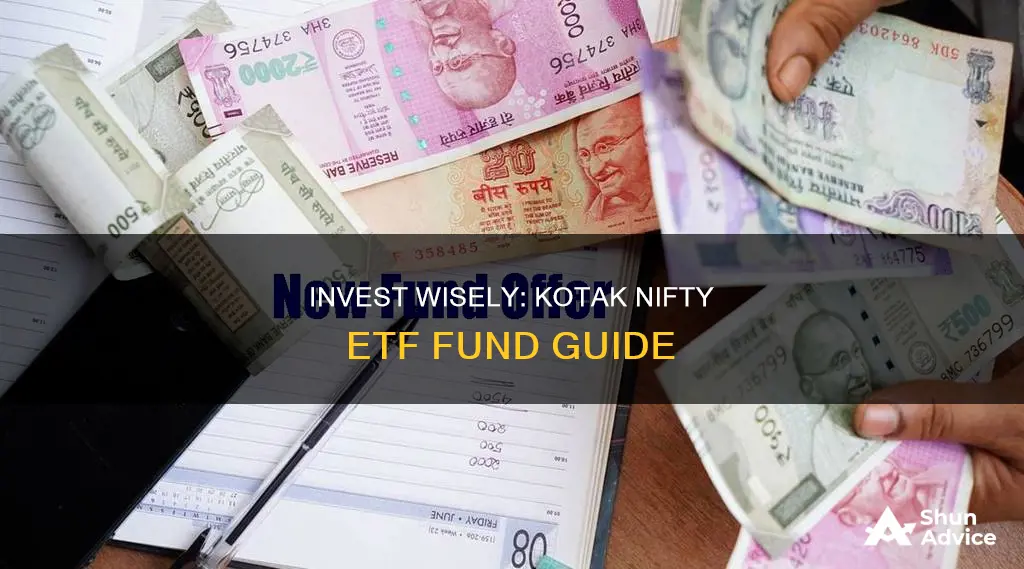
The Kotak Nifty 50 ETF is a fund that invests in big companies, with a portfolio largely consisting of large-cap stocks and debt instruments. This conservative investment strategy means that the fund tends to fall less when stock prices drop, making it a good choice for conservative equity investors. The fund has no minimum lock-in period and can be purchased directly from the website of the fund house, in this case, the Kotak Mahindra Mutual Fund website. It is also possible to buy the fund through platforms like MF Central and MF Utility. As of 31st July 2023, the fund had an AUM (assets under management) of ₹2,066 crore.
| Characteristics | Values |
|---|---|
| Investment Type | Exchange-Traded Fund (ETF) |
| Investment Objective | Replicate the performance of the Nifty 50 Index by buying the same stocks in the same proportion |
| Investment Suitability | Long-term investors seeking limited risks |
| Investment Risk | Very High (as per SEBI's Riskometer) |
| Investment Style | Passive management |
| Investment Holdings | 99.62% in Equity, 0.38% in Cash & Cash Eq |
| Investment Strategy | Conservative |
| Expense Ratio | 0.12% |
| NAV | ₹207.2953 (as of 21-Aug-2023) |
| AUM | ₹2,066 Cr (as of 31-Jul-2023) |
| Minimum SIP Amount | Not available |
| Lock-in Period | No lock-in period |
What You'll Learn

The benefits of investing in Nifty ETFs
Nifty ETFs are a type of exchange-traded fund (ETF) that tracks the performance of the Nifty 50 Index, which consists of the 50 most valuable and liquid stocks of the largest companies in the Indian market. Here are some benefits of investing in Nifty ETFs:
Limited Risk and Stable Returns
Nifty ETFs invest in blue-chip stocks, which are shares of the largest and most established companies in the country. These companies are known for providing stable returns over the long term and offer security from market volatility. This makes Nifty ETFs suitable for investors seeking long-term investments with limited risks.
Cost Efficiency
Investing in individual blue-chip stocks can be expensive. Nifty ETFs, on the other hand, allow investors to gain exposure to blue-chip companies in a cost-efficient manner. The expense ratios of Nifty ETFs are also relatively lower compared to other mutual funds, making them a more affordable investment option.
Instant Diversification
The Nifty 50 Index spans over a dozen sectors of the Indian economy, including banking, finance, technology, and infrastructure. By investing in a Nifty ETF, you instantly gain diversified exposure to multiple sectors and industries, reducing the risk factor associated with individual stock volatility.
High Liquidity
Nifty ETF prices are updated throughout the day, allowing investors to trade them at any time. This provides high liquidity, giving investors the flexibility to buy or sell their investments according to real-time market values.
Simple and Passive Investment Strategy
Unlike mutual funds, Nifty ETFs have no bias or judgment in their stock purchases. They simply buy stocks that are part of the Nifty 50 Index, making their investment strategy easy to understand and follow. Additionally, Nifty ETFs are passively managed, meaning fund managers only need to ensure that the ETF holds the Nifty stocks in the right proportion. This passive management further contributes to cost efficiency.
Maximizing Scholarship Funds: Investment Strategies for Students
You may want to see also

How to invest in Kotak Nifty 50 ETF
The Kotak Nifty 50 ETF is a fund that invests in large companies, and its portfolio is largely conservative. It is mandated to invest at least 80% of its assets in large-cap stocks at all times. The fund is passively managed, meaning it replicates the portfolio of its chosen benchmark index. As of 31-Jul-2023, Kotak Nifty 50 ETF had invested 99.62% in equity and 0.38% in cash and cash equivalents. The fund has delivered 11.85% returns since its inception 13 years ago.
- Mutual funds can be bought directly from the website of the fund house. For instance, the Kotak Nifty 50 ETF fund can be purchased from the website of Kotak Mahindra Mutual Fund.
- You can also buy mutual funds through platforms like MF Central, MF Utility, among others.
- If you are not comfortable buying mutual funds online, you can seek help from a mutual fund distributor. Most banks also act as mutual fund distributors, so you can connect with your bank for assistance.
It is important to note that the Kotak Nifty 50 ETF is a large-cap fund, and you must invest in it only through the SIP route. Do not invest in this fund if you need to redeem your investment in less than five years.
Closed-End Funds: Registered Investment Companies Explained
You may want to see also

The risks of investing in Kotak Nifty 50 ETF
As with any investment, there are risks associated with investing in the Kotak Nifty 50 ETF. Here are some key risks to consider:
Market Risk: The value of the ETF is subject to market fluctuations. While the Nifty 50 ETF invests in large-cap stocks, which are generally considered more stable, the overall stock market can still experience downturns, affecting the value of the fund. It is important to remember that past performance is not indicative of future results, and there is no guarantee of positive returns.
Tracking Error: The ETF aims to replicate the performance of the Nifty 50 Index, but it may not always achieve this perfectly. Tracking errors can occur due to various factors, such as transaction costs, fund management, or changes in the composition of the index. These errors can lead to deviations between the ETF's performance and that of the index.
Liquidity Risk: While the Nifty 50 ETF provides high liquidity, investing in ETFs themselves may carry liquidity risk. ETFs trade on stock exchanges, and in certain market conditions, there may be reduced liquidity, impacting an investor's ability to buy or sell the ETF easily.
Concentration Risk: The Kotak Nifty 50 ETF invests primarily in large-cap stocks, and within that, it may have a higher concentration in specific sectors or individual stocks. Any negative event affecting these sectors or companies could have a more significant impact on the ETF's performance.
Expense Ratio: While ETFs generally have lower expense ratios than actively managed funds, the Kotak Nifty 50 ETF does have an expense ratio of 0.12%
Exchange Traded Funds: Investing in India's Future
You may want to see also

The expense ratio of the fund
The expense ratio of the Kotak Nifty 50 ETF fund is 0.12%. This is considered low compared to other mutual funds. The expense ratio is the annual fee that the fund charges you to manage your money. It is deducted from the Net Asset Value (NAV) on a daily basis. For example, if you have invested 10,000 and the expense ratio is 2%, you would have paid 200 rupees in fees to invest in mutual funds.
The expense ratio is lower for the Kotak Nifty 50 ETF fund than for other mutual funds because it is passively managed. This means that fund managers do not need to rely on their research to pick the right stocks. Instead, they simply need to ensure that the fund has bought stocks in the right proportion to match a specific index. This passive management style also means that fees tend to be lower for this type of fund.
The Kotak Nifty 50 ETF fund is a large-cap fund that invests in big companies. These funds tend to fall less when stock prices fall and are therefore considered more conservative. The fund has no minimum holding period and can be purchased directly from the website of the fund house, in this case, the Kotak Mahindra Mutual Fund website.
Index Funds: Smart Savings or Risky Business?
You may want to see also

The fund's historical performance
As of the 19th of September 2024, the Kotak Nifty 50 ETF fund's Net Asset Value (NAV) was ₹275.9914, with a 0.15% change from the previous day. The fund's historical performance compared to other funds in the category is unknown, as it has no rank.
The fund has a total investment of ₹2601.76 Cr, with a 0.04% expense ratio. The portfolio turnover ratio is 40.37%, and the fund manager has updated the portfolio more frequently than peers in the last year.
The fund has a 99.83% investment in domestic equities, with 82.11% in Large Cap stocks and 3.33% in Mid Cap stocks. The top 10 stocks in the portfolio include Reliance Industries Ltd., Tata Consultancy Services Ltd., and Larsen & Toubro Ltd.
The 1-year return for the fund is unknown, but the 3-year return is 15.71% and the 5-year return is 106.06%. The fund's share price, as of the 11th of October 2024, was 24,964.25, with a market capitalization of 458.61 Lac Crs and $5.46 Tn.
Invest Wisely: Graphene Mutual Funds for Beginners
You may want to see also
Frequently asked questions
The Kotak Nifty 50 ETF fund is a large-cap fund that invests in big companies. It is mandated to invest at least 80% of its assets in large-cap stocks at all times.
You can buy mutual funds like the Kotak Nifty 50 ETF fund directly from the website of the fund house, in this case, the website of Kotak Mahindra Mutual Fund. You can also buy mutual funds through platforms like MF Central and MF Utility. If you are uncomfortable buying mutual funds online, you can seek help from a mutual fund distributor, such as a bank.
The fund provides returns before expenses that closely correspond to the total returns of the Nifty 50, subject to tracking errors. It offers limited risk as it invests in blue-chip stocks on the Nifty Index, which are the largest companies in the country. These companies offer stable returns over the long term and security from market volatility. The fund also provides instant diversification as the Nifty Index consists of the 50 most valuable stocks spanning more than a dozen sectors of the Indian economy.
As with any investment, there are risks involved. The Kotak Nifty 50 ETF fund has a very high-risk level according to SEBI's Riskometer. While it tends to fall less when stock prices drop compared to funds that invest in smaller companies, you must invest only through the SIP route and be prepared for ups and downs in your investment value. Additionally, do not invest in this or any other large-cap fund if you need to redeem your investment in less than five years.







